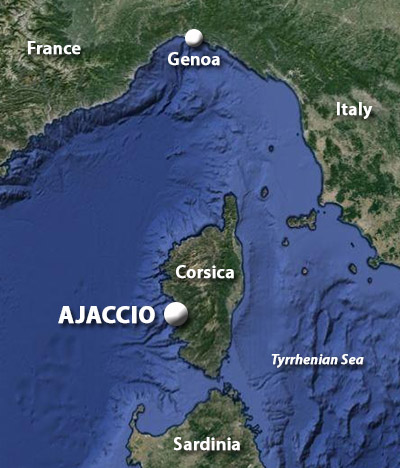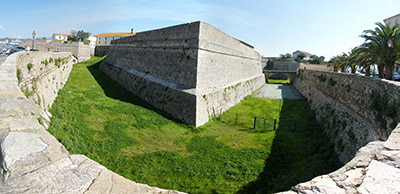 |
Citadelle d'Ajaccio
Ajaccio, Corsica, France
|
|
 |
Constructed: 1554-1559
Used by: Genoa, France
Conflicts in which it participated:
None
Also known as: San Carlu Citadel
|
Napoleon Bonaparte (1769-1821) was born in the little Corsican town of Ajaccio. This has absolutely no bearing on this lovely, irregularly-shaped starfort, but I figured I'd just get it out of the way.
The town of Ajaccio may or may not have been Roman in origin, as island of Corsica was integrated into the Roman Republic in 260AD, and there are ancient references to a town called Adjacium in the region. To what was this town adjacent, to receive such a name? Unexplained.
In the 8th century many of Corsica's seaside towns diminished or disappeared entirely, and Ajaccio somehow ceased to exist. By the late 15th century, the powerful city-state of Genoa was in charge of things on Corsica, and rebuilt Ajaccio as a means to assert its dominance. |
 |
 |
|
The Genoese built what was no doubt a menacing, impressive-looking tower at the location of the starfort of our current interest in 1487 and 1488. This tower watched over the rebuilding of the city in 1492, as a Genoan colony: Corsicans were banned from the town for many years.
|
The Citadelle Ajaccio's most photographed portion: A lovely Guérite at its western tip. |
 |
By the mid-16th century, the Habsburgs, as represented by Spain's King Charles I (1500-1558), had become the dominant force in much of Europe, and had wrested Corsica from Genoa's control. In 1551, France's King Henry II (1519-1559) declared war against Spain and allied with the Ottomans, who had a strong navy ready to wreak havoc in the Mediterranean Sea.
Aided by the Ottomans, France invaded Corsica in 1553, where they would stay until 1559. During this period, the first elements of the Citadelle d'Ajaccio that we see today were built. This noble project was headed by Jourdan des Ursins (1500-1564), a Corsican general of the French army. The Italian War was ended with the signing of the Treaty of Cateau-Cambrésis on April 3, 1559. |
|
|
Most of Corsica was returned to the control of Genoa, including Ajaccio, with its brand-spanking-new French starter starfort: Thanks, France! The initial Citadelle d'Ajaccio sounds like it must have been kind of weird, with two big towers serving as bastions, but fortunately the Genoans knew what was up, and gave the fort some pointy bastions and a moat.
|
Genoa did a poor job of overseeing their Corsican flock, and the Corsican movement for independence began in 1729. Over the next 40 years, France became more and more involved in "securing" Corsica for Genoa, until finally Corsica was "sold" to France in 1768. The Corsicans, who thought they were nearing independence, were universally displeased.
|
 |
An early plan of the Citadelle d'Ajaccio, including a whole lot of extra stuff that is not there today. |
|
French troops moved into the Citadelle d'Ajaccio in 1770, and added various things to its defenses more or less continually until their departure in 1829. In 1769, the aforementioned Napoleon Bonaparte was born. One would like to imagine that, as a Corsican tot, he may have pointed at the Citadelle and said something like, "C'est un starfort, n'est-ce pas?"
|
 Inside the Citadelle d'Ajaccio's dry moat. I like how the delapidated fence to the right says, "we kind of don't want you going in here, but...yeah, whatever. We ain't fixin' it." |
 |
Though France was stripped of most of its empire at the conclusion of the Napoleonic Wars (1803-1815), nobody seemed particularly interested in doing anything with Corsica: Least of all the Corsicans, who ultimately decided they kind of enjoyed being "French."
France's first prison for children was built in Ajaccio in 1855. Somehow the felonious youngsters were not incarcerated in the Citadelle, despite just about every other starfort in Europe being used for a prison at one point or another. |
|
|
Today, the Citadelle d'Ajaccio, perhaps in shame over never having been used to imprison children, is not open to the public.
|
|
|
|
|
|
 |




